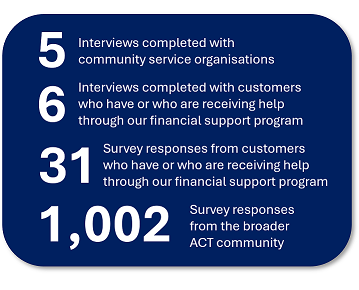
Understanding financial vulnerability
As part of our work to ensure affordability and support for vulnerable customers, we have completed a targeted research and engagement program to understand the experience of financial hardship in the local context.
Findings from this program will underpin future strategic and investment decisions and assist in our review and refinement of support for customers experiencing short- or long-term financial difficulty.
Our engagement (April 2024 to June 2024)

What our customers told us are factors impacting their ability to pay:
- Hardship and financial vulnerability are a spectrum of lived experiences that can be short-term and/or long-term.
- The current economic environment has seen changes to those seeking financial support. Only one third (35%) of customers are able to live comfortably and almost half (44%) are able to meet basic expenses with a little left over for extras.
- The cost of living crisis was named by all community organisations as a recent and rising contributing factor to financial hardship. It has meant that organisations have helped people that have not sought financial support before, including many more homeowners. Many customers find themselves in a situation where their bills are increasing at a faster rate than what they are earning.
- Domestic violence support is increasing amongst community service organisations and often involve helping people move, as well as keeping basic services and utilities going, including phone, electricity, internet and water.
Our key learnings to improve support for our customers and their ability to pay:
- Being a trusted source: Being trusted by customers to do the right thing by them is crucial to them feeling comfortable to ask for support.
- Taking a proactive approach: Support should be proactive and not reactive. Waiting for customers to accrue a certain amount of debt can often be too late for those in extreme hardship.
- Collaborating with other organisations: There are many community and government organisations in the ACT that provide different forms or levels of financial support for Canberrans. Working with these organisations can help improve support for customers and promote the Staying Connected program.
- Investigating customers’ individual circumstances: Hardship can take many forms and often affects many aspects of someone’s life. Organisations need to be mindful that they may not be the only organisation providing support to a customer at the one time.
- Acting in good faith: Initiatives such as matching payment agreements provide positive incentives for customers to work at reducing their debt and are seen as acting in good faith.
What next:
We better understand the full spectrum of financial hardship experienced by our customers and these insights help us review and improve our financial support program.
Find out more about our current financial support services and Staying Connected hardship program here.
